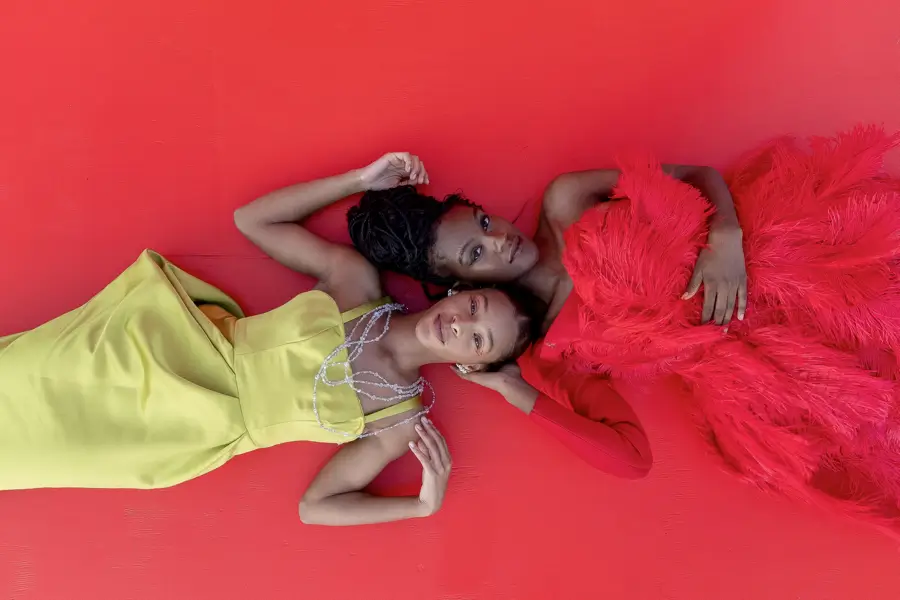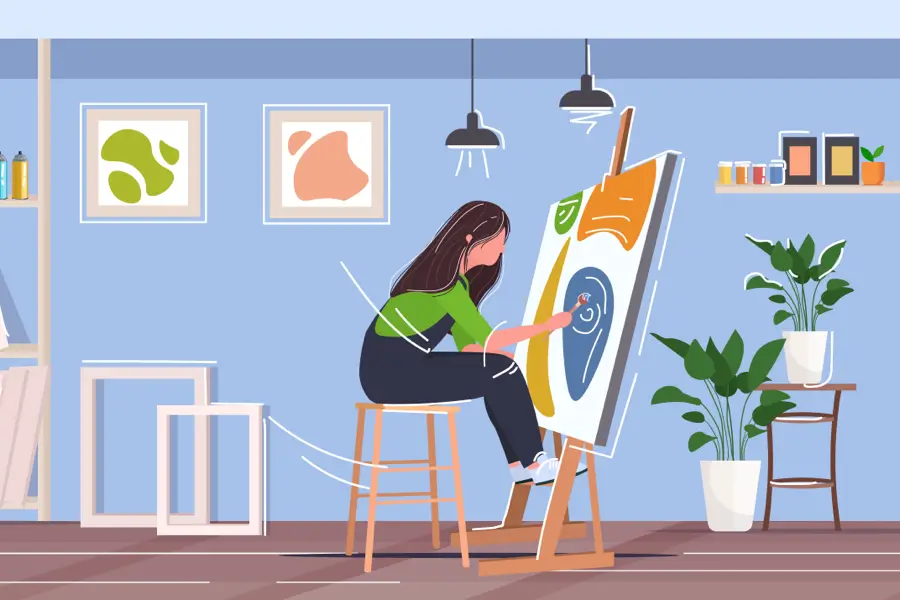
PROFESSIONAL DEVELOPMENT

Make no mistake, no matter how talented you are as an artist, it will be difficult to find recognition for your work — from an employer or a gallery — if you don’t have the portfolio to back up that talent. Considering the competition in all areas of the art world, there is no way that employers and gallery owners have time to research and intensely vet each candidate fully, so they rely on your portfolio to showcase your ability instead.
The difference between portfolios and resumes is that portfolios come in all shapes and sizes, and they are not intended to show off your educational background and work experience; they are intended to showcase your ability in a certain discipline. Different artistic industries require different types of portfolios, but there are some general rules of thumb that anyone who needs to create an art portfolio should think about before they begin the process. Enjoy!
Think of your portfolio as your first impression. What you send to galleries and potential employers is essentially an extension of you as an artist. People forced to show potential employers their paper resumes are the unlucky ones. They get to talk about their talents and experiences, but they don’t often get the opportunity to wow the potential employer with their ability. People with portfolios get to do that. They get to showcase their ability as an artist in their discipline, but they only get one chance to make a first impression, which is why making sure the portfolio contains your best works is crucial.
If you are a talented artist who has worked on honing your craft for years, chances are you have created a lot of pieces — some of them great, some of them awful, and some of them decidedly in between. In some cases, it can be difficult to choose five or six examples of your best work, but that is what you need to do. Universities may have wanted to see your growth as an artist over time, and your ability to learn on the fly, but these employers want to know how skilled you are right now, and that’s why when you have the opportunity to show them your talent, you better choose the works that show that talent wisely.
There are still too many students who take the attitude that they have done enough good work that separating the “best” from the “really good” isn’t all that important. Those students are wrong. You are in charge of what goes into your portfolio, which means you are your own editor, and if you want your portfolio to be bullet-proof, you can’t be afraid to be a very tough editor on yourself. Ask for the opinion of others, compare and contrast your work, and ask fellow students what sort of plan they had for their portfolio. Remember, this isn’t a rough draft that you get to improve once employers point out mistakes, this is your job audition, make it count.
Considering how important your portfolio will be once it comes time to start looking for jobs, no one should look at you funny if you have already started thinking about and planning your portfolio long before it is even time to graduate. Planning ahead can help you locate and correct mistakes before anyone else sees them; it also gives you a much better plan of attack for when it’s crunch time and your portfolio needs to be finished. Maybe some of your classmates will look at you weirdly when they flip on the television, and you leave the room to finish the first of many drafts of your portfolio, but that attention to detail and quest for perfection will only make the finished product that much stronger.
That said, when you are about to start working on a piece, put the portfolio out of your mind because the last thing you want to do is create a piece of artwork specifically because you think it will work perfectly for your portfolio. As we said earlier, if you are a talented and dedicated artist, your entire portfolio is going to grow organically. By the time you are ready to choose which works you want to include in your portfolio, you will probably have a litany of options to choose from. It is important that when you start the selection process, each work starts on equal footing, and then that changes as you weigh each piece and compare and contrast them with others.
If you have been thinking too hard about your portfolio, you may have tunnel vision. Remembering that you created three excellent pieces sophomore year specifically for your portfolio is great, but it may mean that you are neglecting better choices by settling for what you remember. And when it comes to creating the perfect portfolio, there is no such thing as settling. Striking a balance between thinking about it early and obsessing over it is difficult, but if you can master it, you will be better prepared for the process and will keep an open mind about what to include.
In many ways, this piece of advice is both similar and very different from advice that would be given to someone crafting their resume. No matter your job or industry, standing out is often the difference between landing a competitive job and another month or two on the unemployment line. Of course, when 800 people are applying for the job, and your only chance to stand out is a piece of paper and, if you are lucky, an in-person interview, standing out is easier said than done. In recent years, as the job market has grown more competitive and more candidates enter the marketplace, potential employees have tried harder and harder to stand out, with mixed results.
Sometimes, the idea is so creative, funny, or unique that the employer can’t help but stand up and take notice. Other times, attempts at standing out can fall flat, and instead of remembering you for your creative and ingenious resume, they are remembering you as the candidate who tried to stand out with that cheesy poem or by making your cover letter try to sound funny. Needless to say, if they are remembering you as the cheeseball with the terrible poem, the chances you land that job are not very good at all. This is why it is important to remember to try and be unique without overreaching your bounds, especially with a portfolio. Luckily, it’s easier to stand out for people with a portfolio because, ostensibly, the work you are showcasing is your own and no one else’s. It is easier for a potential employer or gallery owner to grow attached to a candidate because of their impressive creations than it is to get attached to a name on a piece of paper, which is why it is even more important not to go wild on your portfolio.
Yes, it is easier for a candidate with a portfolio to stand out, but because there is more flexibility in terms of what a portfolio should look like, a portfolio also makes it easier for a candidate to get too crazy and turn their portfolio into what looks like an elaborate wedding invitation. There are ways to stand out that will impress, and there are ways to stand out that are over the top, and drawing the line between the two is difficult. Just don’t try too hard. Once your portfolio is finished, don’t spend too much time thinking about little ways it can be improved, because that is usually what leads to a giant pink fluorescent heart ending up on your portfolio, and that would not go over well.
We get it. You are a big, bad, independent artist who hasn’t needed help from anyone to get this far, so you aren’t going to accept any help now. While your independence and desire to create a career all by yourself is admirable — it is also really foolish. The number of people who have succeeded while also rejecting help that was offered is very minuscule, and as the art industry continues to grow more competitive and difficult to enter by the day, rejecting free advice, suggestions, or assistance is only setting yourself back in your job search.
This applies to portfolios in particular. Chances are, once you start working on a portfolio, that will become the first portfolio you have ever tried to create. This isn’t to say that you are bound to screw it up the first time no matter how hard you try. It is just to say that when you create it for the first time, you may end up omitting something that is really important. The good news is that you are not the first person who needed to create a portfolio, and you are not the first person who has needed help creating it. Generally speaking, your colleagues, teachers, and art friends will be more than willing to help you by sharing their experiences, offering advice, and making you think about certain things. If they are willing, it makes no sense not to use their assistance. You could be the most talented painter in the entire world, and it still won’t hurt to show your portfolio to someone with more experience before you submit it for review.
The art world is full of egos, and sometimes those egos help an artist stand out, or help inspire their work. But in this instance, it makes more sense to check your ego at the door and use all the resources at your disposal. Not because you will necessarily need all the resources but because…well…you will probably need all the resources you can get.
Picking which works you want to include in your portfolio is hard enough. It doesn’t seem important to think about the rest of your portfolio, right? That line of thinking is frighteningly common among students who are creating their first portfolio. They spend so much time worrying about what pieces to include, they neglect to consider basic aspects like design, layout, punctuation, grammar, etc. The absolute last thing you want is to create a perfect portfolio with some of the best works of art any employer has ever seen and then have your entire application torpedoed because you mixed up “you’re” and “you’re,” or because you stupidly mistyped the name of the place you are applying.
Grammar and punctuation aren’t the only things you also need to consider. Just as with a typical resume, you want to make it as easy as possible for the employer to find all of the important information without having to search too hard. That means space out your portfolio, don’t go overboard on the information you include, the bright colors you use, or the design you want. Think simple and effective. Think classy, elegant, and easy to read. Think colorful and eye-catching while also thinking that you don’t want to make the employer’s eyes bleed.
From start to finish, creating a portfolio is an exhausting process that will take a lot of correcting and changing. It is only natural for you to finish and feel exhausted, or for you to just want the whole process to be over. Everyone goes through it. It’s just that some people recognize they need to fight through it and make it perfect, while others are content to rest on their laurels and hope it works. Guess whose portfolio is more likely to impress?

The Art Career Project is a trusted resource for emerging and professional artists.